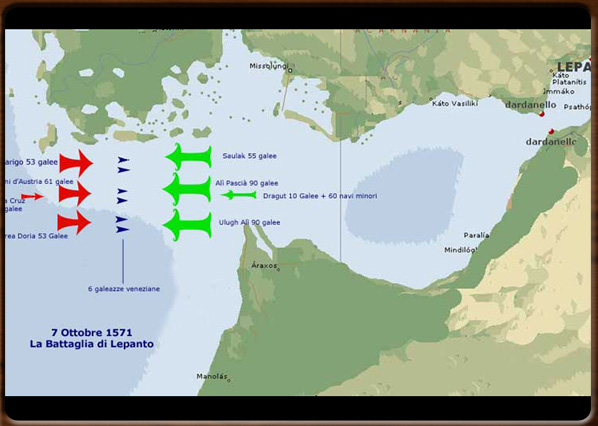
Battle of Lepanto.

No video
There followed several years of relative peace until the middle of the 1400s, when the l'Ottoman Empire began its conquest of the West: first Costantinople in 1453, then Serbia in 1459, followed by Bosnia in 1463, Herzegovina in 1483 and Hungary itself, thus losing any future hope of regaining control over Dalmatia. The Ottomano advance meant that the Turkish and Venetians boundaries met, resulting in a proliferation of border wars.
In 1508, the League of Cambrai defeated the Venetian troops on other fronts, giving the Turks the chance to conquer most of Dalmatia in 1537 after defeating Hungary. Venice thus retained its control of just the coastal cities in Dalmatia.
Christian Slavs fled from the occupied territories and the Turks, pouring onto the coast and islands, swelling the city populations. They easily outnumbered the local Italian population and increasingly spread their language.
One of the most famous of these fugitives was the Uscocchi people, which had settled on the coast near Split.
Encouraged by the Austrians, they carried out acts of piracy against the Turks along the sea routes held by the Republic of Venice against the Turks. This led to a bloody war lasting 80 years. The Uscocchi pirates were belligerent and tenacious despite their number (no more than 2000) and were only defeated and annihilated in 1617, after the outbreak of the War of Gradisca, a city between Venice and Austria.The famous battle of Lepanto in 1571 marked the defeat of the Turkish navy by the Venetians navy and those of the members of the Holy League (Spain, Genoa and the Papal States). Many Dalmatians enrolled in Venetian fleet in support of their new homeland, thus considerably strengthening the Venetian navy.
The second half of the 1600s saw the war between Austria and Turkey which ended with the Peace of Karlowitz in 1699, which marked the decline of the Ottoman Empire and made Austria the dominant power in South-Eastern Europe.
The peace treaty was very favourable for Venice, granting it the entire Dalmatian and Herzegovina coastlines, with the sole exception of Ragusa, which remained a free domain.
In the 18th Century, Dalmatia was finally at peace and thus enjoyed a period of intense economic and cultural growth: the trade routes were re-established and many Istrians and Dalmatians migrated to the Venetian lands.
These became full citizens of the Venetian Republic and even local distinguished figures (the Tonzig family in Padua of Dalmatian origin boasted a bishop and a mayor). In 1797, with the fall of the Republic of Venice, all political relationships between Venice and Dalmatia ceased.
1300 - 1400 - - rev. 0.1.6